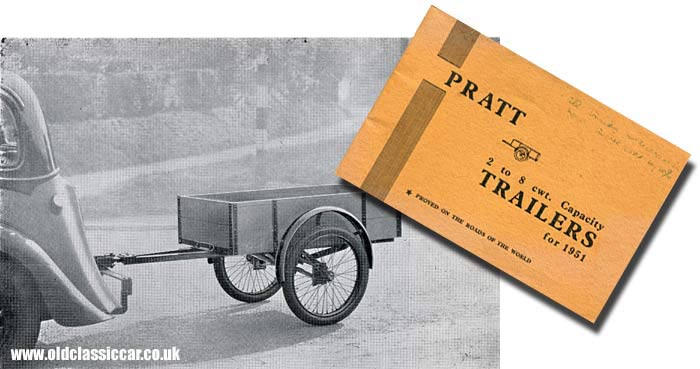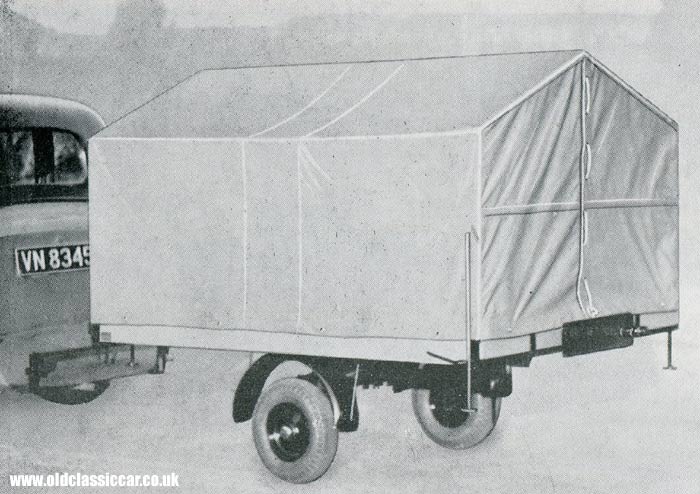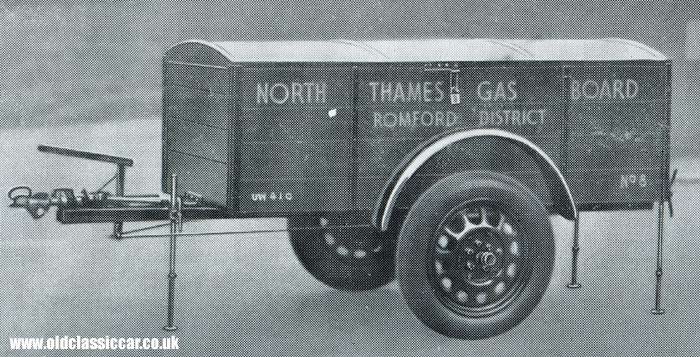Pratt motor-car trailers .
Return to the vintage and classic trailer section.
|
|
Anyone who's ever owned one of the smaller cars produced in the early 1930s, from the days before separate boot space became popular, will be all too aware that storage can be something of an issue. Fold-down luggage racks offered something of a solution, but with one's cases exposed to rain, mud and road spray, careful and water-tight packaging was essential. A family of four wedged into a compact motor, such as a Model Y Ford, or perhaps an Austin 10, would have found little room to spare on a trip to the seaside. Dad would have ensured that he had somewhere convenient to lodge his pipe and tobacco, with mum having laid out her knitting, plus accoutrements. In the back, their two children would have been comfortable enough, wedged in with books and sweets for the trip, but any extra baggage would have been something of a squeeze. The luggage rack, or perhaps one of the roof racks offered by third party accessory manufacturers of the day, would have been virtually essential.
|
|
Alternatively, perhaps a trailer would have been the answer? Some practice in manoeuvring with the trailer attached to the back of one's Ford 8 or Austin 10 might prove to be beneficial, prior to setting off on holiday and preferably away from prying eyes, but this option would free up the car's interior somewhat, and - if a cover was included with the trailer - it offered a broadly water-tight solution to the transportation of holidaying essentials.
|
|
Some years back, I bought a trailer produced in Yorkshire by the Pratt Engineering Company, and recently a visitor to the site was kind enough to post me the original sales catalogue shown below. In it, a wide variety of small-to-medium-sized trailers are described, in addition to towing accessories, backed up with plaudits received from happy customers. The catalogue dates to 1951, but the firm first started producing trailers in 1934, as will be explained. First though, an introduction to their products.
|

|
|
Shown above, the Pratt Type L1 trailer.
|
|
Since their introduction in 1934 PRATT TRAILERS have enjoyed the most gratifying and consistent success until today PRATT'S have the largest distribution and service organisation of any manufacturer of trailers of similar type.
|
|
With their smart appearance, great strength and rigidity, light weight, superb springing and unique coupling PRATT TRAILERS are in a class by themselves, and, produced in a most efficient manufacturing plant they are offered at prices which make them the most outstanding value in trailers at the present time.
|
|
PRATT TRAILERS have been supplied to customers in many countries including Canada, Norway, Egypt, Iraq, Iran, India, The Sudan, Kenya, Rhodesia, South Africa, Nigeria, Morocco etc. and they have received the most enthusiastic praise from trade and public alike.
|
|
... Illustrated and described in this catalogue is the range of Pratt Luggage, Goods, Farmers and Camping Trailers for loads of from 2 cwts to 8 cwts.
|
The range on offer.
The range of trailers on offer was extensive. All were finished in three coats of synthetic paint, Battleship Grey to the woodwork, and black to the metal parts including the chassis. Curiously, if Pratt supplied just a chassis, as they often did, that would be finished in Battleship Grey also. Bare chassis were available rated at 2cwt (£20 0s 0d) right up to 8cwt (£46 0s 0d), these prices including numberplate, tail lamp and cable, and the company's own design of coupling. The main models on offer are now described.
|
Type L1.
This was the company's lightweight offering (shown above), designed for small cars and motorcycle combinations. Despite being very light, it would "... stand any amount of hard wear and knocking about". It was available in two ratings - 2cwt, and 3cwt.
|
Type L2.
The L2 was based on the L1, but incorporated a drop-down tailgate and a detachable waterproof cover utilising lift-the-dot fasteners, all laid over a metal frame. This too was available in 2cwt or 3cwt ratings, the price difference between the two being £2 0s 0d.
|

|
Type E1 and E2.
The Pratt E1 was a slightly larger trailer and could accommodate loads of 4, 6 or 8cwt. The E2 was similar to the E1 but, as with the L1/L2, offered a drop-down tailgate and removable cover for the load area, for which a premium of £10 0s 0d was asked over the E1's prices. An example of the E2 is shown below, attached to the back of a 1930's car, registration VN 4868 (Yorkshire). A trailer such as this is the perfect accessory for any pre-war car used regularly even today, although a more conventional hitch may be a good idea.
|

|
Type E3 and E4.
The E3 and E4 incorporated higher sides when compared to the previous models, and were designed with farmers, market gardeners and poultry keepers in mind. A drop-down rear door was standard fitment, with 4cwt, 6cwt and 8cwt versions available. The E3 (not shown) was photographed attached to a different car (reg. WX 7776), while the E4 was photographed attached to the two-tone car used in most of their images. The E4 (shown below) was similar to the E3, but had taller sides, similar to "greedy boards" fitted to pickup trucks, allowing taller loads to be carried.
|

|
Type E5.
The E5 trailer was based on the E3 but came with a tall removable frame and waterproof cover. It is described as being ideal for the transportation of dogs, poultry, or any other load that needed protection from the weather. Prices started at £42 0s 0d and topped out at £64 0s 0d. Maybe it's the airbrushed photographs, but the towbars fitted on the cars, to which these trailers are shown attached, don't look to be the sturdiest ever invented. Different designs of towbar are shown fitted to the car registration VN 8345 throughout the catalogue's 36 pages.
|

|
Type E6.
Tradesmen needing to transport long items, such as ladders or lengths of wood, may well have been interested in the Pratt E6, shown next. A sturdy iron frame has been added to the trailer's basic design, enabling longer items to be carried, projecting forwards over the rear of the car's roof. Very handy.
|

|
Type E7 streamlined trailer.
"Streamlined to match new-car styling" the sales pitch goes, and the E7, with its rakish hinged aluminium load cover, is a neat-looking little trailer, available rated at either 4cwt or 8cwt. The cover could be opened up to 90 degrees, and featured a lockable handle to secure the contents once folded down again. Rubber beading fitted to the lower edge of the cover sealed the interior from outside dampness and dust.
|

|
Type H1 and H3.
The H-series was designed with the transportation of bulky loads in mind. Bee-keepers, needing to move hives, or dealers needing to shift bulky items of furniture, were just some of the likely buyers suggested for the Type H1 and H3. The use of small wheels, fitted with Dunlop 16 x 4 Extra Heavy tyres, enabled them to be nestled beneath the trailer's load area, offering a much more usable load space, as the rear view ably demonstrates. The H1 and H3 were virtually identical, except for the latter having sides that extended a further 5.5 inches higher (9.25" as opposed to 3.75").
|

|
Type C1 - Camping Trailer (trailer tent).
Many private buyers would choose to purchased a trailer in order to go camping, and Pratt's had just the model for them, the C1. It was "... extremely light so that it can be towed with ease by even an 8hp car in any type of country ..." so perfectly suited to the hordes of pint-sized Fords, Hillmans, Austins and Morrises that buzzed around the roads of Britain, before and after WW2. The C1 was in fact an early design of trailer tent, in that two beds were incorporated within its design, enabling two campers to snuggle down beneath its waterproof covering. Minus beds, the C1 was on sale at £48 0s 0d, or with two beds and matching storage bags, at £58 0s 0d all in, perfect for the camper out there who didn't want to struggle erecting a traditional frame tent. The C1 shared much of its design with the previously mentioned H3 model.
|

|

|
Type MTS and MTL.
Both versions were 8cwt trailers, designed to carry tools, goods and other weighty objects. The trailer was constructed from 3/4" tongue and groove timber, topped with a sturdy side-hinged lid made from aluminium sheeting (re-cycled RAF Spitfires perhaps following WW2?) over a timber frame, to which a hasp and padlock were fitted. The MTS was priced at £72 0s 0d, and the MTL at £78 0s 0d, the latter being 6ft rather than 5ft in length, with 19" high sides rather than the 12.5" high sides of the MTS. Both measured 3ft wide, and came with car-type easi-clean wheels. The MTS trailer illustrated in the catalogue is in the livery of the North Thames Gas Board (Romford District), but any lettering could be applied to the customer's specifications.
|

|
Customer recommendations.
The final four pages of the catalogue feature some of the comments sent to the firm by happy customers. These date to the 1930s and 1940s mainly, and reflect the company's international customer base, a sample of which are repeated below.
|
|
"Just a note to tell you that the trailer was an outstanding success, and that I found the absence of luggage etc cluttering up the inside of the car, made an appreciable difference to the comfort of the journey. The Standard (8hp) didn't appear to notice the presence of the trailer at all, and petrol consumption worked out at 35 mpg for 820 miles" Assistant Editor of "The Light Car", London, 1946
|
|
"I have now been using the trailer for the past fourteen months, towing same behind my 600cc Panther combination. It has proved to be a splendid investment indeed. The steering of the combination is entirely unaffected and the springing of your trailer on roads good or bad is a revelation." Darwen, 1949.
|
|
"Pratt Trailers are obviously of high quality workmanship." California, USA, 1947.
|
|
"You will remember that I bought a Pratt H1 trailer from you last April. I mentioned at the time that I wanted it chiefly for transporting bees. It is exactly the right size for carry 6 Nationals (hives). The bees travelled the 12 odd miles to heather extremely well, since the springing of the trailer is excellent and allows no jars whatsoever. Of course I have used the trailer for various other loads; personal luggage, bags of cement and boxes of tools. For all these it has given equally excellent service."Somerset, 1947.
|
|
"I bought a 3cwt capacity Pratt trailer through your Bristol agents and have used it to bring my luggage from Oxford to Calais then across France to Geneva and thence over a pass called the Coll de Moes to this place in the mountains near Chateau d'Oex, a journey of 900 miles. The trailer behaved beautifully and I am well satisfied with it. I am being often asked for the loan of this trailer and it is much admired."Switzerland, 1948.
|
|
Buyers in the North of England could buy a Pratt trailer from the works at Northallerton. An advertisement inside the rear cover of the catalogue also refers to Isaac Agnew Limited, the main distributor located in Belfast, Northern Ireland. Lambert Brothers (Merchandise) Limited, of London, handled the export of Pratts products to all four corners of the globe, so trailers bearing their brass, oval-shaped, manufacturer's badge, could have been encountered just about anywhere.
|
|
Evidently, in its day, this firm was a major producer of trailers in the UK, up there with the likes of Dixon-Bate and Leason. The catalogue mentions that the first trailers were built in 1934. A document found online refers to the company being wound up in August 1965 by founder and Chairman, K.H. Pratt. A later meeting with the liquidator was scheduled for January 1966.
|
|
How many more examples of this once-popular trailer survive out there? I'd be interested to see photographs of any other survivors. My small example is in quite good condition, possibly still in its original black and grey colour scheme, albeit with a later hitch fitted. I'd like to find another of the dummy knock-on wheel spinners shown fitted to it, if anyone has a spare? My old motorcycle trailer is missing one.
|

|
|
Vintage and classic trailer section.
|
















